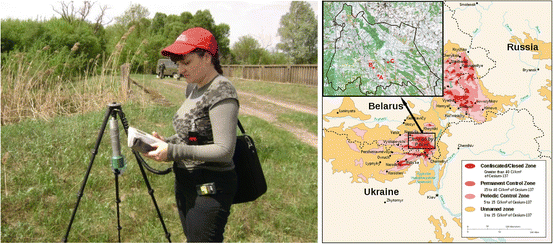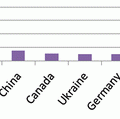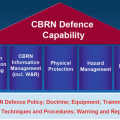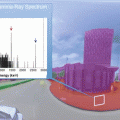Fig. 24.1
A map of the South Caucasus river network (left) and Metsamor NPP (right)
This unique cooperative long-term research was implemented in the frames of a NATO Science for Peace (SfP)/OSCE project N977991 ‘South Caucasus River Monitoring’ (2002–2007), partner countries: Armenia, Azerbaijan, Georgia, USA, Belgium and Norway.
A rationale behind continuous monitoring and assessment of radioactivity of Rivers Kura-Araks basin waters and controlling possible radioactive pollution was a presence of an operating Metsamor NPP in Armenia (the only one in the region as of 2002), planned exploration of U deposits in the country, regionwide development of nuclear technologies, intentions to erect NPPs in neighboring countries.
The biggest challenge for cooperation in the South Caucasian region was unstable military and political situation between Armenia and Azerbaijan and lack of trust. Another challenge was lack of а water quality management system (in terms of specific pollutants such as heavy metals, POPs and radionuclides), modern instrumentation and analytical procedures as well as application of international QA/QC standards in the three South Caucasian republics.
24.2.2 Region II: Central Asia (Tajikistan)
The collaboration was built with an intention to assess environmental radioactivity status of former uranium mining and tailing sites in the north of Tajikistan (Fig. 24.2).


Fig. 24.2
A map of the Central Asian region (left) and the Republic of Tajikistan with indication of the 2008 field mission sites (right)
Uranium ore mining and processing in the former Soviet Republic of Tajikistan was initiated after the World War II. One of consequences of those activities have been huge amounts of generated uranium tailing materials and waste rock deposits, often found dumped close to inhabited areas. Key sources of concern have been technologically enhanced levels of naturally occurring radionuclides (TENORM).
In August 2008 a joint field mission was taken as a part of a ‘Joint project between Norway, Kazakhstan, Kyrgyzstan and Tajikistan: Environmental impact assessment of radionuclide contamination of selected uranium mining and tailing sites’ (coordinated by the Norwegian University of Life Sciences and funded by the Norwegian Ministry of Foreign Affairs), and a NATO SfP project N981742 ‘RESCA – Radioactivity Environmental Security in Central Asia’ (coordinated by the Josef Stefan Institute, Slovenia).
Given a lack of a proper waste management in most of former uranium mining and tailing sites in the study region, there exists a considerable risk of contamination spread far beyond the limits of presently known contaminated sites, making thus nuclear and radiological risks and potential transboundary contamination an international challenge [3].
24.2.3 Region III: Belarus (Chernobyl Exclusion Zone)
А study site for this cooperative research was the Belorussian sector of the Chernobyl Exclusion Zone (CEZ). The overall goal for international cooperation in this area (Fig. 24.3) was to obtain comprehensive information on radioactive contamination of the territory of the Polessie State Radiation-Ecological Reserve (PSRER) and to monitor transboundary transport of contamination to the territory of Belarus as a result of extreme natural phenomena, such as fires and flooding [1].
This joint research was done in the frames of a NATO SfP project N983057 ‘Polessie State Radiation’ in partnership with Belarus, Ukraine and Norway.
Although numerous radioecological studies were conducted within the CEZ in the years following the Chernobyl accident of 1986, nonetheless there were significant uncertainties associated with mapping of radionuclide distribution and transboundary contamination [1].
24.2.4 Region IV: Euro-Arctic
The Euro-Arctic region has become a region of international importance. Environmental radioactivity is of special concern to the Arctic region due to numerous existing and potential sources of radioactive pollution in immediate and adjacent areas (Fig. 24.4). Besides, sub-Arctic and Arctic food chains are short, this providing a potentially quick uptake route for contaminants to reach biota and the man. This fact, too, supports a necessity to continuously monitor environmental radioactivity particularly in areas which are actively used by local people for collection of natural food products ([4, 5, 9]).
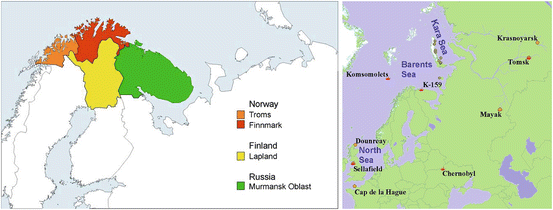

Fig. 24.4
A joint project site in the Euro-Arctic region (left) and sources of radionuclides in the northern marine environment (right, NRPA [7])
The three partner countries: Norway, Finland and Russia have already developed their own requirements to emergency preparedness, radiation protection and environmental monitoring [8]. To jointly mitigate challenges in the Euro-Arctic region, it is essential that direct collaboration be built between key authorities, research organizations and stakeholders in the three partner countries and procedures and methodologies be harmonized to strengthen emergency preparedness capabilities in the High North. It is also important to get comparable data for environmental and other risk assessments for the entire Euro-Arctic region vs. restricted assessments for each country. So, we made a suggestion that a cross-border cooperation network be built and areas identified that would focus on specific issues and challenges, and later implemented it the frames of the CEEPRA KO130 project ‘Collaboration Network on Environmental Radiation Protection and Research’ under financial support of the EU Kolarctic ENPI CBC Programme and the Kolarctic Norge.
24.3 Methods
As pointed out earlier, each of the regions had specific challenges, needs and topics for international cooperation. Besides, the regulation, monitoring procedures and emergency preparedness approaches were also different in all partner countries.
A prerequisite for successful implementation of the four described projects was development of a specific cooperation plan and strategy for each of the four regions that would both meet the joint project goals and comply with demands of local authorities. An essential aspect of cooperation was identifying pathways for harmonization of approaches and a possibility to get credible and comparable data for combined environmental and other risk assessments. Also, cooperation included improvement of analytical procedures, measurement techniques and modeling capabilities in partner countries, joint field works, practical experience exchange and inter-comparisons (both in-situ and inter-laboratory), discussion of approaches for subsequent follow-ups.
Stay updated, free articles. Join our Telegram channel

Full access? Get Clinical Tree


